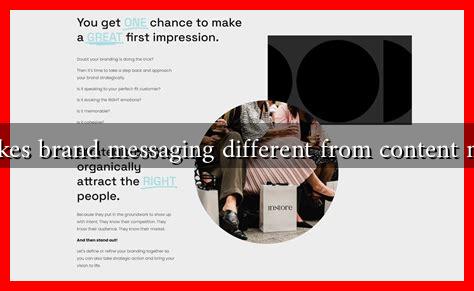-
Table of Contents
- What Makes Brand Messaging Different from Content Messaging
- Defining Brand Messaging
- Key Characteristics of Brand Messaging
- Understanding Content Messaging
- Key Characteristics of Content Messaging
- Comparing Brand Messaging and Content Messaging
- Case Studies: Successful Brand and Content Messaging
- Case Study 1: Coca-Cola
- Case Study 2: Buffer
- Conclusion
What Makes Brand Messaging Different from Content Messaging
In the ever-evolving landscape of marketing, understanding the nuances between brand messaging and content messaging is crucial for businesses aiming to connect with their audience effectively. While both play significant roles in a company’s communication strategy, they serve different purposes and require distinct approaches. This article delves into the key differences between brand messaging and content messaging, providing insights and examples to clarify their unique functions.
Defining Brand Messaging
Brand messaging refers to the underlying value proposition and emotional appeal that a brand communicates to its audience. It encompasses the core values, mission, and vision of the brand, aiming to create a consistent identity that resonates with consumers. Brand messaging is often encapsulated in taglines, mission statements, and overall brand voice.
Key Characteristics of Brand Messaging
- Consistency: Brand messaging must remain consistent across all platforms and touchpoints to build trust and recognition.
- Emotional Connection: It aims to evoke emotions and foster a sense of loyalty among consumers.
- Long-term Focus: Brand messaging is designed for longevity, focusing on the brand’s overall identity rather than specific campaigns.
For example, Nike’s brand messaging revolves around empowerment and inspiration, encapsulated in their famous slogan, “Just Do It.” This messaging is consistent across all their marketing efforts, reinforcing their identity as a brand that champions athleticism and perseverance.
Understanding Content Messaging
Content messaging, on the other hand, refers to the specific messages conveyed through various content formats, such as blog posts, social media updates, videos, and infographics. It is more tactical and focuses on delivering valuable information, engaging storytelling, or entertainment to the audience.
Key Characteristics of Content Messaging
- Informative: Content messaging aims to educate or inform the audience about a particular topic or product.
- Short-term Focus: It often addresses current trends, events, or specific campaigns, making it more transient than brand messaging.
- Variety of Formats: Content messaging can take many forms, including articles, podcasts, videos, and social media posts.
A great example of effective content messaging is HubSpot’s blog, which provides valuable insights on marketing, sales, and customer service. Their content is designed to educate their audience while subtly promoting their brand and services.
Comparing Brand Messaging and Content Messaging
While both brand messaging and content messaging are essential for a successful marketing strategy, they differ significantly in their objectives and execution. Here are some key comparisons:
- Purpose: Brand messaging focuses on building a long-term relationship with consumers, while content messaging aims to provide immediate value or information.
- Audience Engagement: Brand messaging seeks to create an emotional connection, whereas content messaging often encourages interaction through comments, shares, and likes.
- Measurement: The success of brand messaging is often measured through brand awareness and loyalty metrics, while content messaging is evaluated based on engagement rates and conversion metrics.
Case Studies: Successful Brand and Content Messaging
To illustrate the differences further, let’s look at two case studies:
Case Study 1: Coca-Cola
Coca-Cola’s brand messaging emphasizes happiness and togetherness, encapsulated in their tagline, “Open Happiness.” This messaging is consistent across all their advertising campaigns, reinforcing their identity as a brand that brings people together.
Case Study 2: Buffer
Buffer, a social media management tool, excels in content messaging through its blog, which offers valuable insights on social media strategies. Their content is designed to educate users while promoting their services, showcasing the effectiveness of content messaging in driving engagement and conversions.
Conclusion
In summary, while brand messaging and content messaging are both vital components of a marketing strategy, they serve different purposes. Brand messaging focuses on building a long-term emotional connection with consumers, while content messaging aims to provide immediate value and engagement. Understanding these differences allows businesses to craft more effective marketing strategies that resonate with their audience. By leveraging both types of messaging, brands can create a cohesive narrative that not only attracts but also retains customers.
For further reading on effective brand and content messaging strategies, consider exploring resources from HubSpot and Branding Magazine.

